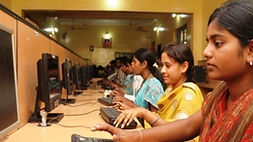simple | organised | relevant | comprehensive
SECTORS
Skill Development

Introduction
According to the National Policy for Skill Development and Entrepreneurship,
more than 54 per cent of India’s population is below 25 years of age and
62 per cent of India’s population is aged between 15 and 59 years.
This demographic dividend is expected to last for the next 25 years. India has the opportunity to supply skilled labour globally and become the world’s skill capital.
Current Status
The National Skill Development Policy estimates that only 5.4% of the workforce in India has undergone formal skill training (as compared to 68% in the UK, 75% in Germany and 96% in South Korea).
The India Skill Report 2018 states that only 47% of those coming out of higher educational institutions are employable.
India’s annual skilling capacity was estimated at approximately 7 million during the period 2013-2014.
Major Challenges to Skill Development
Mapping skill requirements sector-wise and geographically.
Making vocational training an aspirational choice.
Involving industry for improved quality and relevance – scaling up the apprenticeship programme.
Integrating the informal sector into the skill development ecosystem.
Putting in place an effective, internationally recognized assessment and certification system.
Steps taken by the Government
1. Ministry of Skill Development and Entrepreneurship (MSDE) - a dedicated ministry was set up in 2014
2. Skill India Campaign launched in 2015 with following components:
National Skill Development Mission 2015 – aims at creating convergence across various sectors and different states with respect to activities relating to skills training. The mission, apart from consolidating and coordinating skilling efforts, would also facilitate decision making across sectors to achieve quality skilling on a large scale.
Pradhan Mantri Kaushal Vikas Yojana (PMKVY) – It is a skill certification scheme that aims to encourage the young population of the country to take up training which is industry-relevant and builds them in skill development.
National Policy for Skill Development & Entrepreneurship - The chief objective of this policy is to match the challenge of skilling at scale with speed, standard (quality), and sustainability. It aims to offer an umbrella framework to all skilling activities carried out within India, to align them to common standards and connect skilling with demand centres.
Skill Loan Scheme - Under this scheme, loans ranging from Rs.5000 to Rs. 1.5 lakhs will be provided for those seeking to attend skill development programmes. The idea behind the scheme is to remove financial hurdles for people who want to upgrade their skills and learn new skills.
3. To improve the relevance and quality of courses offered by industrial training institutes (ITIs), polytechnics and private training providers, sector skill councils (SSCs) have been involved in curriculum up-gradation/preparation, and in the assessment and certification process.
4. Indian Skill Development Service (ISDS) - It is a new central government service to attract young and talented people into the skill development domain and make skilling initiatives successful in the country.
National Skill Development Mission
Objectives
Create an end-to-end implementation framework for skill development
Align employer/industry demand and workforce productivity with trainees’ aspirations for sustainable livelihoods
Establish and enforce cross-sectoral, nationally and internationally acceptable standards for skill training in the country
Build capacity for skill development in critical un-organized sectors
Leverage existing public infrastructure and industry facilities for scaling up skill training and capacity building efforts.
Support weaker and disadvantaged sections of society through focused outreach programmes and targeted skill development activities.
Maintain a national database, known as the Labour Market Information System (LMIS), which will act as a portal for matching the demand and supply of skilled workforce in the country.
Shortcomings in the Desired Outcome
1. The target of Skill India was to reach out to 300 million young people by 2022, but only 25 million had been trained under this scheme by the end of 2018.
- This is partly due to mismanagement and partly due to not spending available funds because of lack of candidates.
- Even those who have been trained under Skill India and PMKVY are unable to find jobs.
2. The number of those who have benefited from the Skill India scheme has increased, from 3,50,000 in 2016-17 to 1.6 million in 2017-18, but the percentage of those who could find a job upon completion of their training has dropped from more than 50% to 30%.
3. Under PMKVY, only 15% of those trained got a job.
Way Forward
1. Mapping skill requirements for a demand driven skill development ecosystem.
2. Improving training delivery and quality
Capacities of teacher training institutes need to be upgraded to ensure the availability of qualified trainers.
A single regulatory body with branches in all states should be set up to lay down minimum standards for all players in the skilling system
3. Vocational education in secondary schools along with incentivising the private school participation
4. Facilitate the integration of the micro, small & medium enterprises (MSME) sector into the apprenticeship system by linking it to MUDRA scheme.
5. Mainstreaming skill development with education through a system for academic equivalence to ITI’s qualifications.
6. An Overseas Employment Promotion Agency should be set up at the national level under the Ministry of External Affairs.
7. Alternative financial resources such as CSR, CAMPA, MPLAD funds should be tapped to expand the skill program.
8. Monitoring and evaluation - Since skilling is dynamic, it is necessary to monitor programmes regularly. Hence, it is necessary to develop state level indicator.